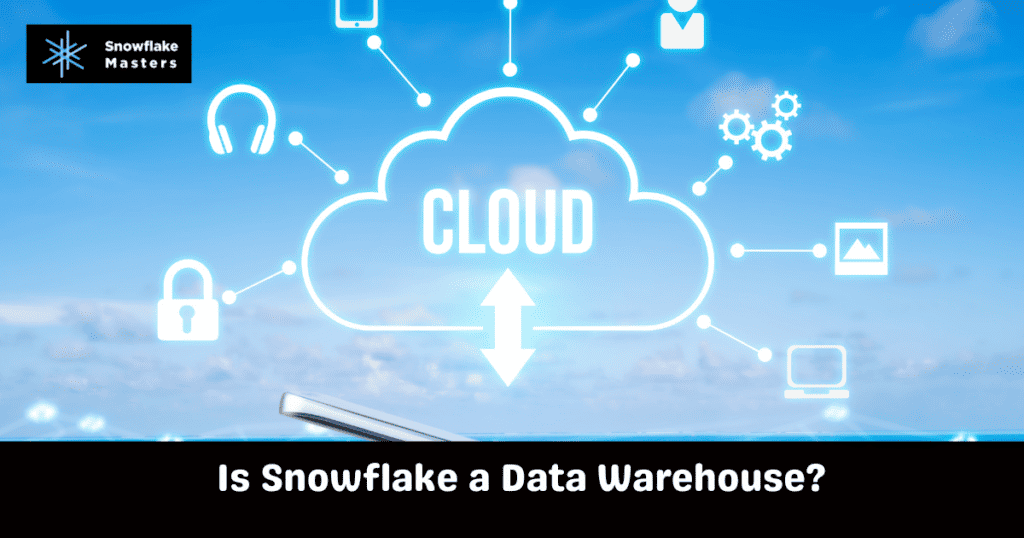Is Snowflake a Data Warehouse? Here's What You Need to Know
Is Snowflake a Data Warehouse?

When it comes to data warehousing, Snowflake has been making waves in recent years. But is it a data warehouse or something else entirely? In this article, we’ll explore the capabilities of Snowflake and answer the question: Is Snowflake a data warehouse?
Table of contents
- What is Snowflake used for?
- Features of Snowflake.
- How Does Snowflake Work?
- Is Snowflake a Data Warehouse?
- What is a snowflake schema in a data warehouse?
- Snowflake vs. Traditional Data Warehouses
- Disadvantages of using Snowflake.
- What is a virtual warehouse in Snowflake?
- Expert Opinions
- Conclusion
What is Snowflake used for?
In simple words, Snowflake is a cloud-based data warehouse platform that allows organizations to store, process, and analyze large volumes of data with high performance, flexibility, and ease. But Snowflake is not just another data warehouse it is a modern data platform built for the cloud, used by companies of all sizes across different industries.
It was founded in 2012 and is based in Bozeman, Montana. The creators of Snowflake started from nothing and created a data platform that uses the huge potential of the cloud. They engineered Snowflake to power the Data Cloud, where thousands of organizations can access data to drive business growth.
- Snowflake’s unique architecture separates computing and storage, providing unlimited scale, instant elasticity, and optimal performance. It offers a pay-as-you-go pricing model that can be cost-effective for organizations of all sizes.
Features of Snowflake.
A cloud-based data warehousing platform, Snowflake, provides several features and capabilities that let users store, handle, and analyze enormous amounts of data. Some of the key capabilities of Snowflake include:
- Separation of compute and storage: Snowflake’s cloud-based architecture separates compute and storage, providing unlimited scale, instant elasticity, and optimal performance1. That allows users to scale computing and storage independently, providing flexibility and cost-effectiveness.
- Virtual warehouses: Snowflake’s virtual warehouses are sets of compute resources used to process queries against data stored in Snowflake2. Virtual warehouses can be created and scaled up or down as needed, allowing users to process queries quickly and efficiently.
- Multi-cluster warehouse: Snowflake’s multi-cluster warehouse enables users to execute multiple queries in parallel, improving query performance and reducing wait times3.
- Data sharing: Snowflake allows users to securely share data with other Snowflake accounts, enabling collaboration and data monetization4.
- Security: Snowflake provides a range of security features, including multi-factor authentication, federated authentication and single sign-on, and data encryption5. All communication between clients and the server is protected through TLS, and deployment inside a cloud platform VPC or VNet provides additional data isolation.
- Built-in analytics: Snowflake provides a range of built-in analytics capabilities, including support for SQL, machine learning, and graph processing6. Snowflake also integrates with popular business intelligence (BI) tools, enabling users to visualize and analyze data in real time.
How Does Snowflake Work?
Snowflake is a cloud-based data warehousing platform that separates computing and storage, providing unlimited scale, instant elasticity, and optimal performance.
Snowflake’s design combines conventional shared disk and shared-nothing database architectures, enabling quick data processing and querying.
When data is loaded into Snowflake, it is automatically split into micro-partitions, allowing for efficient data processing and querying.
Snowflake uses multi-cluster architecture, which means that queries are processed across multiple clusters simultaneously, allowing for faster processing times.
Snowflake has several features that aid with data security, including automated at-rest and in-transit data encryption and the capacity to control user access to data.
In conclusion, Snowflake is an effective data warehousing technology that enables customers to store, handle, and analyze vast amounts of data at scale.
Its unique architecture and features make it a popular choice for organizations of all sizes.
Is Snowflake a Data Warehouse?
Snowflake is a cloud-based data warehousing platform allowing users to store, process, and analyze data at scale.
An analytical relational database called a “data warehouse” is what Snowflake is, and its architecture is ideal for processing and querying massive amounts of data.
Snowflake’s architecture separates computing and storage, providing unlimited scale, instant elasticity, and optimal performance. When data is loaded into Snowflake, it is automatically split into micro-partitions, allowing for efficient data processing and querying.
Snowflake uses multi-cluster architecture, which means that queries are processed across multiple clusters simultaneously, allowing for faster processing times.
Overall, Snowflake’s features and architecture make it a powerful data warehousing platform that allows users to store, process, and analyze large amounts of data at scale.
Its analytical relational database structure aligns with the core characteristics of a data warehouse, facilitating complex querying and data analysis tasks.
Snowflake’s architecture is optimized for handling large volumes of data, making it well-suited for businesses seeking to derive valuable insights from their data assets.
One key advantage of Snowflake’s data warehousing capabilities is its ability to seamlessly integrate with various data sources and tools.
This enables businesses to consolidate disparate data sources into a centralized platform for unified analysis and reporting.
Additionally, Snowflake’s multi-cluster architecture enhances performance by distributing query processing across multiple clusters, enabling faster query response times even for complex analytical tasks.
what is snowflake schema in a data warehouse?
- Snowflake schema is a type of data modeling technique used in data warehousing.
- It is named after its snowflake-like appearance, created by normalizing the dimension tables.
- In a snowflake schema, the fact table is connected to multiple-dimension tables, which are further connected to other dimension tables.
- The dimension tables are normalized, which means they are broken down into smaller tables to reduce data redundancy and improve data integrity.
- The snowflake schema reduces data redundancy, improving performance and reducing storage requirements.
- It also improves data integrity by reducing the likelihood of inconsistencies between tables.
- However, the snowflake schema can be more complex than other data modeling techniques.
- Queries may require more joins, which can affect performance.
- The snowflake schema can be more difficult to understand and maintain than other data modeling techniques.
- The snowflake schema is a useful data modelling technique used in data warehousing to improve data integrity and reduce data redundancy.
- It is important to carefully evaluate your options and consider factors such as complexity and performance before using the snowflake schema or any other data modelling technique.

Snowflake vs. Traditional Data Warehouses
Cloud-based vs. On-premise: Snowflake is a cloud-based data warehousing solution, while traditional data warehouses are often on-premise solutions.
- Scalability: Due to Snowflake’s great scalability, users can quickly add or delete resources as needed. On the other hand, traditional data warehouses are often limited by the hardware they are running on and can be difficult to scale.
- Architecture: Snowflake’s unique architecture separates computing and storage, allowing for better performance and scalability, as well as easier management of data. Traditional data warehouses often have a monolithic architecture, making them more difficult to manage and scale.
- Performance: Snowflake’s columnar storage format and unique architecture allow for faster query performance and better compression. Traditional data warehouses may not have the same level of performance, depending on their architecture and hardware.
- Cost: Snowflake’s pay-as-you-go pricing model can be more cost-effective than traditional on-premise data warehousing solutions. Traditional data warehouses often require a significant upfront investment in hardware and software.
- Learning curve: Because Snowflake is a cloud-based solution, users may need to learn new skills and workflows to use it effectively. Traditional data warehouses may be more familiar to users who are used to on-premise solutions.
- Complexity: Snowflake’s unique architecture can be complex to understand and manage, especially for users used to traditional data warehousing solutions. Depending on their architecture and complexity, traditional data warehouses may be simpler to manage.
Disadvantages of using Snowflake
- Data transfer costs: Snowflake charges for data transfer between regions and clouds, which can add up if you have a large amount of data or use multiple clouds.
- Integration challenges: While Snowflake has several built-in integrations and supports SQL, Python, and other programming languages, integrating with other systems and tools can still be challenging. That can be especially true if you are migrating from a legacy data warehousing solution.
- Limited control: Because Snowflake is a cloud-based solution, users have limited control over the underlying infrastructure. That can concern organizations that require more control over their data and infrastructure.
- Dependency on Internet connectivity: Since Snowflake is a cloud-based solution, it depends on Internet connectivity. That can be a concern for organizations that require high availability and uptime.
What is a virtual warehouse in Snowflake?
- In Snowflake, a virtual warehouse is a set of compute resources used to process queries against data stored in Snowflake. Virtual warehouses can be created and scaled up or down as needed, allowing users to process queries quickly and efficiently.
- Virtual warehouses can be created in Snowflake’s web interface or using SQL commands and can be customized with different sizes, types, and configurations to meet specific needs
- Users can also create multiple virtual warehouses, allowing them to run queries in parallel and improve processing times.
- One of the benefits of virtual warehouses in Snowflake is that they are completely separate from storage, which means that users can scale computing and storage independently.
- That allows users to increase or decrease computing resources as needed without affecting the data they can store.
- Overall, virtual warehouses in Snowflake provide users with a flexible, scalable, and cost-effective way to process queries against data stored in Snowflake.

Expert Opinions
To better understand Snowflake’s capabilities as a data warehouse, we reached out to several experts in the field.
According to a report by Gartner, “Snowflake is a cloud-native, hybrid, multi-cloud, multi-region, and multi-cluster architecture that is designed to be agnostic to the underlying cloud infrastructure.” The report goes on to say that “Snowflake is a data warehouse that is designed for the cloud era.”
In a recent article for Forbes, Snowflake CEO Frank Slootman stated, “We are a data warehouse, but we are also a lot more than that.” He explained that Snowflake is designed to be a “data platform” that can handle a wide range of data-related tasks.
Conclusion
So, is Snowflake a data warehouse? The answer is yes, but it’s also much more than that. Snowflake’s unique architecture and cloud-based design make it a highly scalable and flexible solution for managing and analyzing large amounts of data. While there are some potential drawbacks to using Snowflake, many experts agree that it is a powerful and innovative data warehousing solution.
FAQ’s
Users of the Snowflake cloud-based data warehousing technology can store, handle, and analyze huge volumes of data.
Snowflake is a data warehouse. Their website states Snowflake is “the only data warehouse built for the cloud.”
Snowflake is built on a unique architecture that separates computing and storage. That means users can scale their compute resources up or down without worrying about the underlying storage layer. Snowflake also uses a columnar storage format, allowing faster query performance and better compression.
Some of the key benefits of using Snowflake include scalability, flexibility, performance, and cost-effectiveness. Snowflake’s cloud-based architecture makes it easy to use and manage and allows for greater data storage and management flexibility.
Some potential drawbacks of Snowflake include complexity, a learning curve, and cost. Snowflake’s unique architecture can be complex to understand and manage, especially for users used to traditional data warehousing solutions. Additionally, because Snowflake is a cloud-based solution, users may need to learn new skills and workflows to use it effectively. Finally, while Snowflake’s pay-as-you-go pricing model can be cost-effective, it can also be more expensive than traditional on-premise data warehousing solutions in some cases.
One of the key differences between Snowflake and traditional data warehouses is that Snowflake is built for the cloud. It is designed to be highly scalable and flexible, allowing users to easily add or remove resources as needed. Additionally, Snowflake’s unique architecture, which separates computing and storage, allows for better performance and scalability, as well as easier management of data.
According to a report by Gartner, “Snowflake is a cloud-native, hybrid, multi-cloud, multi-region, and multi-cluster architecture that is designed to be agnostic to the underlying cloud infrastructure.” The report goes on to say that “Snowflake is a data warehouse that is designed for the cloud era.” Additionally, Snowflake CEO Frank Slootman has stated that Snowflake is a “data platform” that can handle various data-related tasks.
The answer to this question will depend on your organization’s needs and requirements. However, if you are looking for a highly scalable, flexible, and cloud-based data warehousing solution, Snowflake may be a good choice. It is important to carefully evaluate your options and consider factors such as cost, complexity, and learning curve before deciding.
Snowflake can store a wide range of data types, including structured, semi-structured, and unstructured data. That includes relational databases, JSON, Avro, Parquet, and more data.
